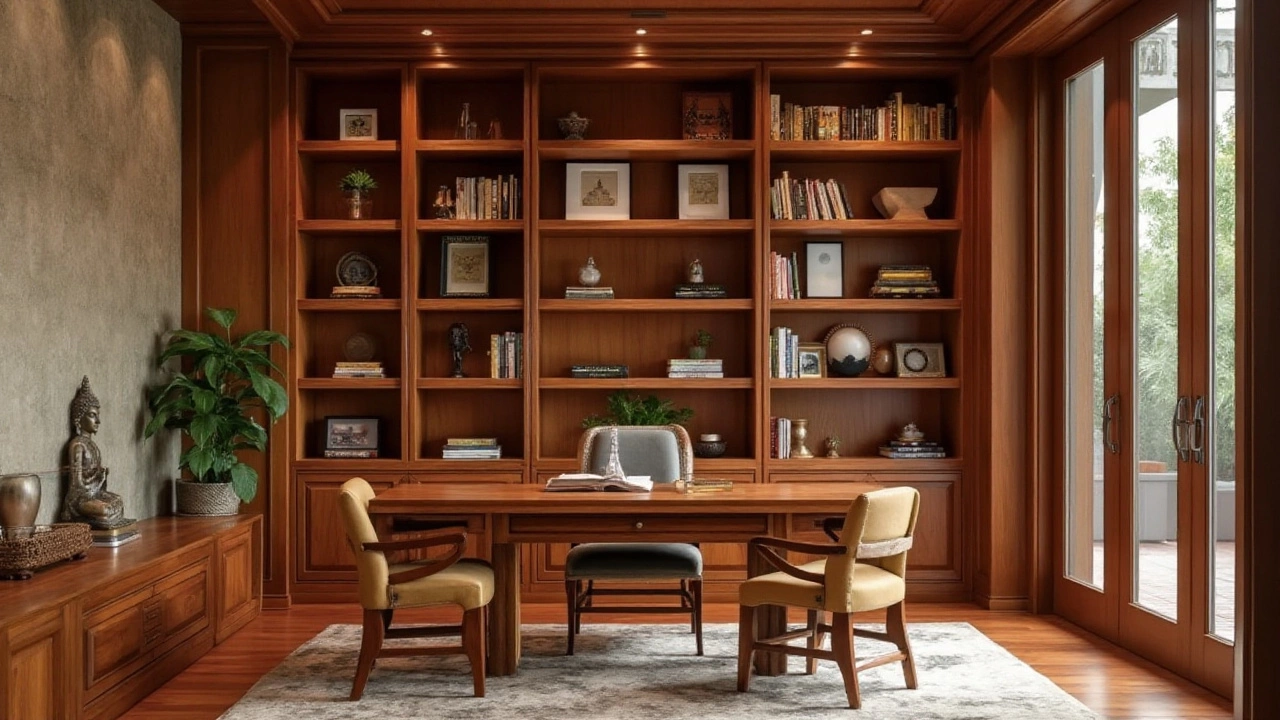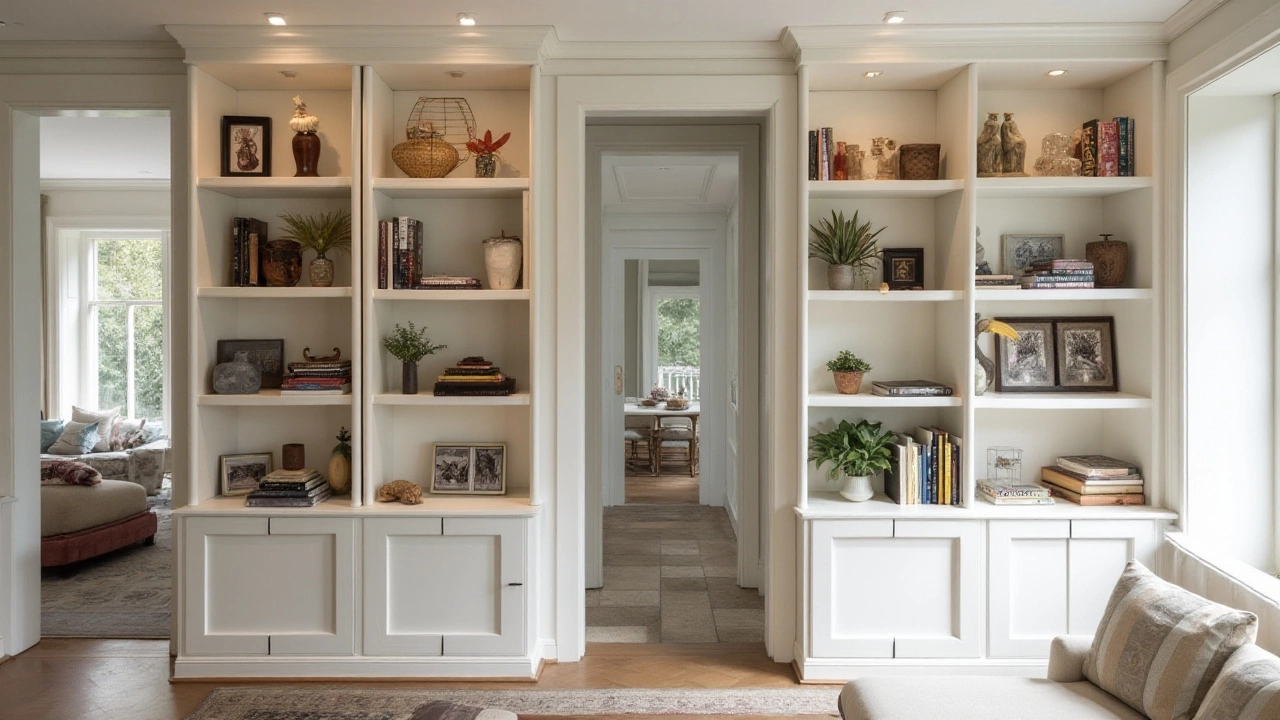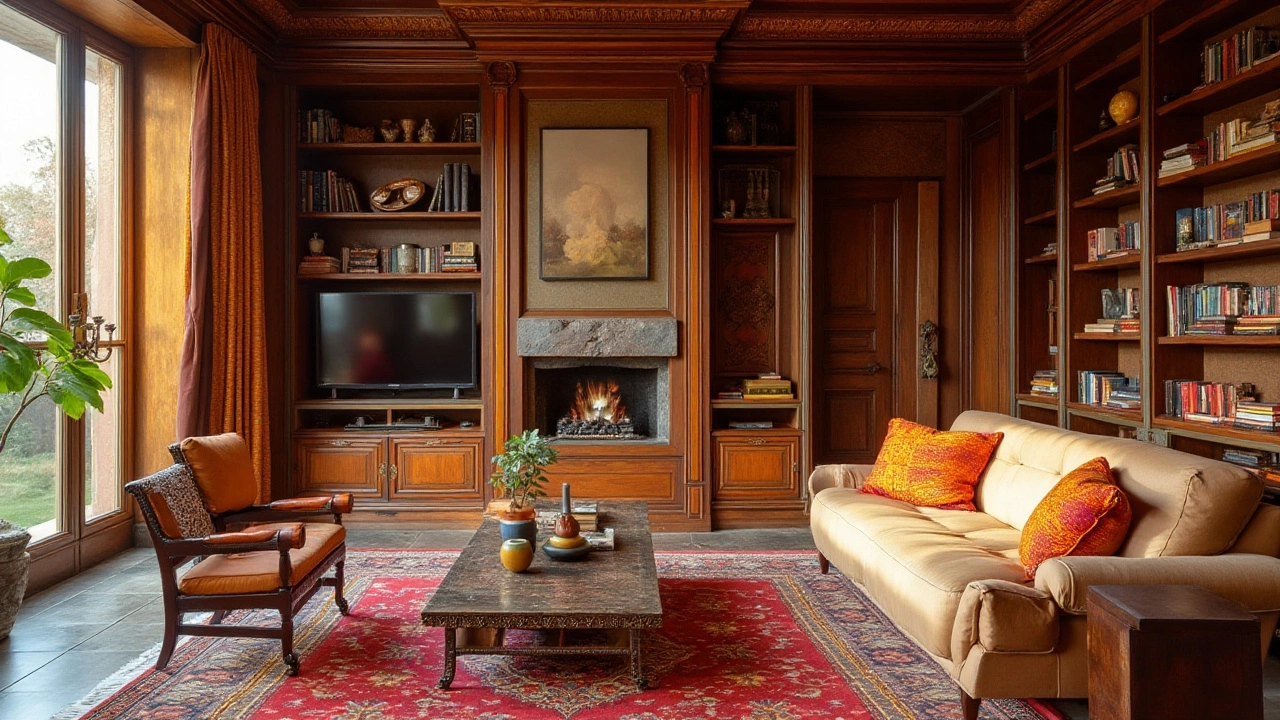When it comes to enhancing the charm and functionality of a home, built-in bookcases offer a unique blend of style and utility. These elegant structures do more than house your beloved novels; they breathe life into living spaces and can leave potential buyers with a lasting impression.
Imagine a room where storage meets art, where your personal literary collection doubles as a statement piece. This isn't just about aesthetics — it's about making your home's features work for you. Whether you're an avid reader or just someone looking to maximize your space, built-in bookcases might just be the improvement your home needs.
- The Appeal of Built-In Bookcases
- Functional Benefits Beyond Appearance
- Impact on Home's Market Value
- Considerations Before Installation
- Design Tips for Seamless Integration
- Alternatives to Built-In Bookcases
The Appeal of Built-In Bookcases
The allure of built-in bookcases is undeniably captivating. From a design perspective, they offer a level of integration and cohesion that simply cannot be matched by free-standing furniture. By becoming a part of the wall itself, these bookcases often create a fluid transition between different elements of a room's architecture. This harmony crafts a visually pleasing environment that appeals to both the minimalist and the traditionalist. The melding of form and function is seamless, combining storage with style in a way that enhances any living space.
For homeowners, the charm of built-in bookcases extends beyond their visual appeal. These fixtures are often seen as a mark of quality and bespoke craftsmanship. Unlike mass-produced shelving units, each built-in bookcase is typically custom-made to perfectly fit the designated space. This custom fit ensures that no area is wasted, which is a crucial aspect of maximizing storage, especially in homes where every square meter counts. In an age where space can be a limiting factor, built-in bookcases can seem like a magical solution.
Another point of attraction is the sense of permanence built-in bookcases bring to a home. They are not only fixtures but features, becoming part of the home's architectural narrative. A stately office with built-ins embodies professionalism and intellect, a cozy living room with a built-in wall unit encourages relaxation and leisure. Each setting has its ambiance, yet all stem from this singular structural enhancement. It's this ability to transform rooms into specific environments that makes these cases a favorite among interior designers.
In the words of noted interior designer Nate Berkus, "Your home should tell the story of who you are and be a collection of what you love." Built-in bookcases certainly enable homeowners to do just that, offering a prominent place to display cherished items alongside books – each contributing to the home's narrative.
Moreover, the appeal of built-in bookcases often extends to potential buyers, adding a real boost to property perception in the real estate market. Buyers appreciate that these bookcases eliminate the need for additional furniture, reducing clutter and often making rooms feel larger and more open. Despite their permanence, built-ins can be quite versatile. They can be adapted over time as personal tastes and storage needs change, whether it be the addition of new shelving, lighting, or decorative touches.
Consideration for built-in bookcases often leads homeowners to imagine their potential homes wrapped with warmth, elegance, and sophistication. The convenience they offer is palpable — no longer is there a need to worry about mismatched furniture or the odd book or item out of place. The summed effect is a lifestyle that is more organized and regimented, all the while maintaining the personality and character unique to each home.
As these shelves stretch from floor to ceiling, they provide a dramatic backdrop that can highlight a home's natural charms. It's no surprise that many equate the inclusion of built-in bookcases to the experience of luxury living. When designed with intent and crafted with care, these architectural elements not only serve a purpose but also become a home's centerpiece, embodying both functionality and flair.
Functional Benefits Beyond Appearance
Built-in bookcases, while striking as an aesthetic element, serve a significant role beyond just visual appeal. They transform any space into a functional area that maximizes every inch of a room’s potential. By adding built-in bookcases, you effectively integrate storage solutions seamlessly into your home’s architecture, making practical use of space that might otherwise go underutilized. This is especially beneficial in homes with limited square footage, where every bit of space counts.
These personalized shelving units bring order and organization, clearing away clutter and simplifying the storage of books, media, and decorative items. With everything neatly displayed or hidden away, your home’s atmosphere shifts towards one of calm and tidiness. Imagine walking into a room where walls aren’t just walls; they’re full of narratives, curiosities, and essentials, all carefully housed within elegantly designed bookcases that add both utility and style.
Another advantage of built-in bookcases is their role in improving a room's acoustics. The absorption of sound by books and shelving reduces noise levels, turning a loud space into a cozy, quiet retreat. This quality can be particularly useful in urban settings where peace and quiet might be hard to come by. In cities like Melbourne, where bustling sounds often penetrate living spaces, having a solid structure to help dampen environmental noise can be a welcomed feature.
Moreover, these bookcases provide an innovative approach to personalization, allowing homeowners to inject their own style and personality into their living spaces through curated displays. Whether showcasing family photographs, artifacts from travels, or an impressive book collection, these customizations can infuse life into static walls. During colder months, this personal touch adds warmth and ties a room together, making it feel inviting and unique. As the designer Nate Berkus once said, "Your home should tell the story of who you are and be a collection of what you love."
Interestingly, data from real estate experts reveal that homes with integrated storage solutions tend to show increased buyer interest. A study showed that properties featuring modern storage amenities, such as built-ins, tend to spend fewer days on the market compared to their less equipped counterparts. This reflects a growing trend in property buyers prioritizing functional enhancements that also double up as decorative accents.
| Feature | Percentage of Buyer Interest Increase |
|---|---|
| Built-In Bookcases | 15% |
| Modern Storage Options | 20% |
Beyond visual and acoustic benefits, built-in bookcases also play a pivotal role in energy efficiency. Acting as additional insulation, especially on outward-facing walls, they can slightly reduce heating and cooling costs by providing an extra buffer against the elements. While the energy-saving impact may not rival more sophisticated insulation methods, every bit helps, especially in a world increasingly focused on sustainability and efficiency.

Impact on Home's Market Value
There is something undeniably charming about a home that boasts custom features like built-in bookcases. These architectural enhancements not only highlight the character and style of a property but also manifest in tangible financial returns. When potential buyers walk through a home, they often take mental notes about where they could put their things, what unique features appeal to them, and how each element fits into their lifestyle. Built-in bookcases provide an edge, transforming what might be an ordinary room into an extraordinary reading sanctuary or an elegant office space.
Studies in real estate have shown that homes with custom features such as built-ins often attract higher valuations. Buyers are willing to offer more for craftsmanship that integrates seamlessly into a home’s architecture, showing that there is a demand for these nuanced additions. They provide a sense of permanence and uniqueness that stand-alone furniture cannot match. Custom bookcases imply quality and care, which are highly sought after in the housing market. According to a report from Zillow, homes with bespoke built-in features typically fetch a notably higher resale price compared to similar homes without such enhancements. Not to mention, these buyers feel as if they’re gaining more than just walls and floors, but rather a thoughtfully designed living space.
"In many cases, the presence of built-in bookcases can tip the scales in favor of a sale. They enrich living spaces and combine functionality with flair, which is irresistible to the discerning modern buyer," says a renowned interior designer in an interview with Architectural Digest.
It’s not just about perceived value; built-in bookcases deliver real use. In cities like Melbourne, where real estate can be costly, every square meter counts. Homes that efficiently utilize space with integrated storage solutions are more desirable to buyers who wish to avoid cluttered environments and maximize their living area. Well-constructed bookcases can enhance the functionality of a home, creating more space without actually expanding square footage, which is invaluable in dense urban areas.
| Feature | Impact on Resale Value |
|---|---|
| Custom Built-Ins | 10-15% Increase |
| Standard Shelving | Up to 5% Increase |
However, the specific design, style, and quality of a built-in bookcase can greatly influence its impact on the market value of a home. Homeowners should work with skilled craftsmen or experienced interior designers to create custom pieces that look like they were part of the original architecture. Poorly executed built-ins can have the opposite effect, detracting from the home’s value and appeal. Paying attention to materials, sizing, and layout are paramount in ensuring the investment is worthwhile. Quality woodwork and thoughtful integration can increase the allure, making it possible for a home to stand out more vividly in a competitive market.
Considerations Before Installation
Before diving headfirst into the world of built-in bookcases, there are several crucial factors to consider to ensure a successful outcome. One of the first points to ponder is the available space. Assessing your room's dimensions is vital because a bookcase should enhance, not overwhelm, a space. Visualize how the structure will interact with existing furniture, windows, and doors. Remember, the goal is to achieve a seamless integration that adds value by complementing the room's architecture, not clashing with it.
Another significant consideration is the purpose behind your built-in bookcase. Are you looking to merely store a collection of books, or do you envision displaying art pieces, family photos, and knick-knacks as well? The function of your bookcase will influence its design and shelf configuration. It's also wise to contemplate the weight of the items you intend to store. Books, for instance, can become quite heavy, necessitating a sturdy build. Consultation with a skilled carpenter or home designer can provide valuable insights.
Material selection plays a key role in determining the longevity and aesthetic appeal of your bookcase. Popular choices include hardwoods such as oak and mahogany, known for their durability and classic look. However, alternatives like engineered wood also offer cost-effective and eco-friendly options. Another tip is to consider finishes that match or complement your existing decor, such as painting the bookcase the same color as the walls to create a cohesive feel.
Jane Smith, a renowned interior designer, once remarked, "A built-in bookcase is not just a piece of furniture. It’s a statement of design intent, demanding foresight and harmony with its surroundings."
Budget is a factor one cannot overlook. Built-in bookcases are an investment, so understanding your financial constraints is essential. Consider the costs of materials, labor, and additional features like lighting or glass doors. It's beneficial to obtain several quotes from reputable contractors to ensure you're getting a competitive price. Look for previous reviews or ask for referrals to confirm the quality and reliability of their work.
Custom or Prefabricated
A decision to make is whether to opt for a custom-built bookcase or a prefabricated one. Custom designs offer flexibility in size, style, and material, perfect for creating a tailor-made fit to your home’s unique specifications. They can be pricier, but the bespoke touch often justifies the cost. On the other hand, prefabricated units might be more affordable and quicker to install but may lack the perfect fit or personal touch. Weighing the pros and cons of these options will guide you toward a choice that aligns with both your vision and budget.
Finally, one must consider the impact of installation on existing structures. Built-in bookcases might require changes to walls or flooring, and such modifications may need professional evaluation and consent, especially if you reside in a property with historical significance or stricter regulations. Checking local building codes can help avoid setbacks and ensure compliance.

Design Tips for Seamless Integration
Creating a built-in bookcase that feels like an integral part of your home's architecture involves a delicate balance of design, craftsmanship, and an eye for detail. One of the first things to consider is the style of your existing space. It's crucial that your new feature matches the current aesthetic, whether it's a traditional Victorian home with ornate woodwork or a sleek, modern apartment with clean lines. The idea is to make the bookcase look like it has always been there, not just an afterthought. Choosing the right materials can significantly help in achieving this effect. Often, using the same wood species or color palette as other furniture or moldings inside the room creates a cohesive appearance.
In terms of dimensions and layout, built-in bookcases can be customized to fit almost any space, whether it's an entire wall or a cozy alcove. To maximize both form and function, think about how you'll use the bookcase. More than just a place for books, it can showcase art, collectibles, or even double as a media centre. This multi-functional use can add value by making the room versatile and adaptable to different needs. Remember to factor in lighting, a critical element often overlooked. Built-in lighting can focus attention on your special items, adding depth and warmth. Integrated LED strips or spotlights can highlight particular objects or sections of the bookcase.
The depth and height of your bookcase will also require attention. Shallower shelves can be perfect for paperbacks or decorative items, while deeper ones can accommodate larger books or storage baskets. Adjusting the height of your shelves according to what they will hold not only optimizes storage but also provides a pleasing visual rhythm. Attention to detail such as this enhances both usability and aesthetic beauty. Don't shy away from experimenting with asymmetrical shelf arrangements; these can provide a dynamic and interesting appearance, breaking the monotony of traditional designs.
Now let’s talk about incorporating unique design features. Sliding ladders bring an old-world library charm and are especially useful for tall bookcases. Glass doors can be added to protect rare items or to give a sophisticated touch. In homes with a more open-floor plan, bookcases can also serve as dividers to subtly delineate space.
“It's all about blending functionality with elegance, ensuring that every piece feels like it's part of a greater whole,” says renowned interior designer Sarah Richardson.Special design considerations are vital, especially if the space is shared with heating or cooling elements, which might require adaptations to ensure proper airflow.
Don’t forget about the finishing touches. Proper trim and molding can turn even the simplest bookcase into a stunning architectural element. Crown moldings add grandeur, while baseboards anchor the piece within the room's design. Paint or stain can offer a way to express personality – a bold hue can make a statement or a lighter color can make a room feel more spacious. And if you're considering adding built-in bookcases to potentially increase your home value, the investment in these details is often worthwhile. As you refine your design, consult with a skilled carpenter or interior designer who understands your vision and can bring it to life with expertise.
Alternatives to Built-In Bookcases
While built-in bookcases are a beautiful addition to any home, they aren't the only option for those looking to boost their space's storage and style. There are several alternatives that offer flexibility, whether you're dealing with a tight budget, a rental property, or simply prefer a different aesthetic. Freestanding bookcases are perhaps the most straightforward choice. Their portability is a huge advantage, allowing you to reconfigure and move them easily as your needs change. This adaptability is ideal for those who frequently redesign or relocate.
Another creative alternative is wall-mounted shelves. These provide an opportunity to create unique and customizable storage solutions. By arranging shelves in a dynamic pattern, they can act as a feature wall while offering practical space for books and decorative items. This option also allows for varying shelf heights, making it possible to accommodate taller volumes or art pieces, thereby enhancing the room's versatility. For a more eclectic look, consider using vintage crates or ladders as book storage. These can add character and an artistic touch to your home, providing a rustic charm that stands out in a crowd of conventional furnishings.
For those who favor a minimalist approach, floating shelf systems can deliver an uncluttered yet elegant appearance. By employing hidden brackets, these shelves give the illusion of books and items hovering mid-air. This can accentuate clean lines and open spaces, which is particularly appealing in modern interiors. Storage ottomans present another intriguing possibility. Not only do they serve as comfortable seating, but they also offer a hidden compartment for books and other items, making them ideal for small apartments or multipurpose rooms. Similarly, a console table with drawers can provide a sleek solution that blends storage with functionality.
Lastly, when considering alternatives, think about custom cabinetry work for tailored solutions. Cabinets can include both closed and open sections, combining traditional storage with the opportunity to display prized books or collectibles. According to interior designer Maxine Brady, "Custom solutions provide the flexibility and personalized touch that off-the-shelf options often lack."
Comparing these alternatives to built-in bookcases, it's clear that while each has its merits and drawbacks, they provide a world of possibilities for those willing to think outside the box. From portability to personalization, the right choice depends on your individual needs, design tastes, and the practical aspects of your living situation.

